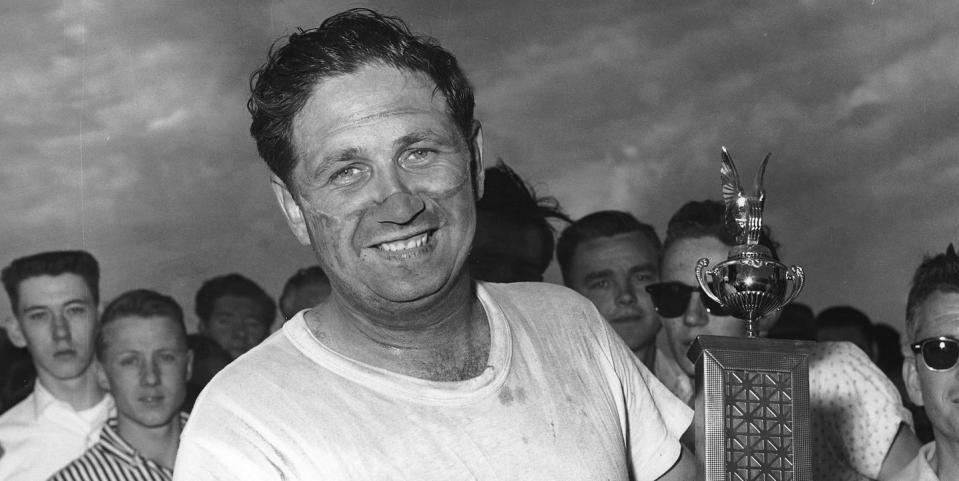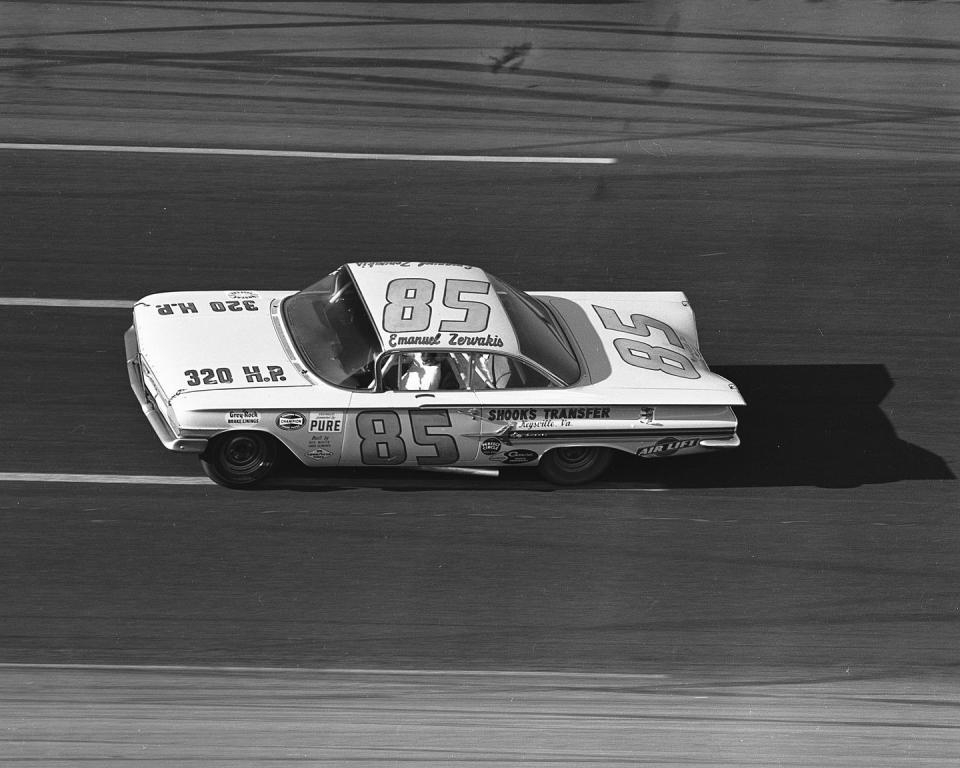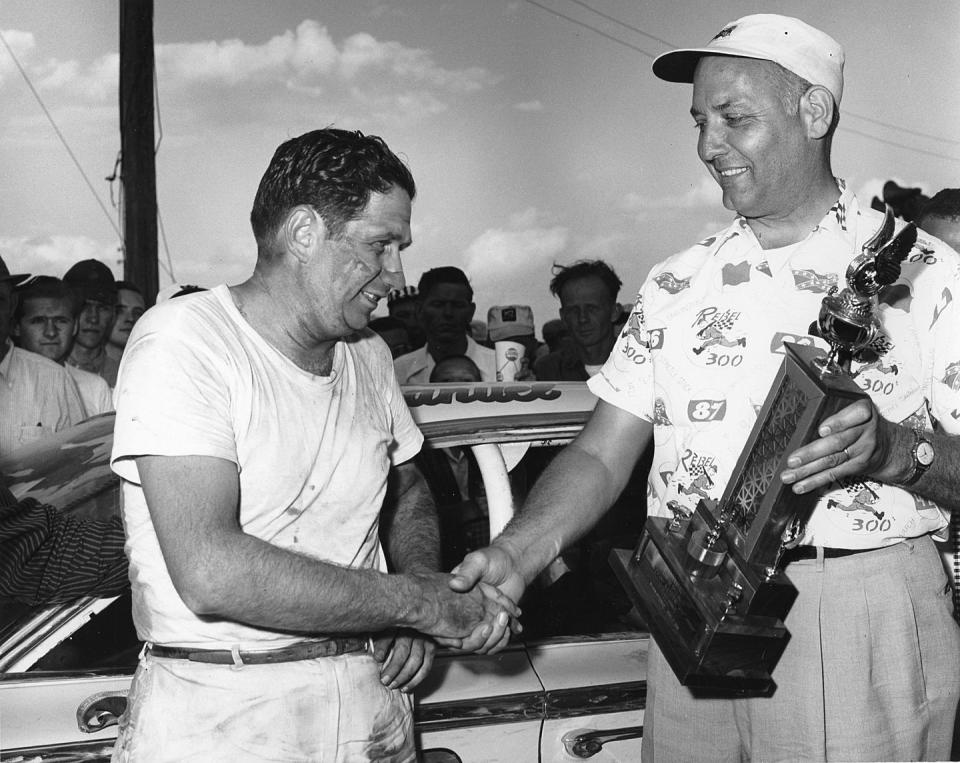Busted: How Emanuel Zervakis and Denny Hamlin Are Forever Linked on Infamous NASCAR List

Emanuel Zervakis, the former NASCAR Cup Series journeyman driver/team owner, was the last race winner disqualified in 63 years before Denny Hamlin was busted on Sunday at Pocono, Pa.
In April of 1960, he thought he’d gotten his first victory, a 200-lap, 100-mile dirt-track event at Wilson, N.C.
Zervakis started from the pole and took the checkered flag, but his No. 85 was found to have an oversized fuel tank.
So, who was this Emanuel Zervakis fellow after all? Deceased since December of 2003, the former NASCAR Cup Series journeyman driver/team owner was the last race winner disqualified in 63 years before Denny Hamlin was busted on Sunday at Pocono, Pa.
Zervakis was among hundreds upon hundreds of underfunded, hands-on, overworked, passionate part-timers in NASCAR’s infancy. He raced and maintained his own Chevrolets between 1956 and 1958, then again between 1960 and 1963. He won two poles and two races in 83 starts, and finished top-10 in 40 of those starts He was good enough to record 19 top-10 finishes during a 23-race stretch in 1961, when he finished third in championship points behind Ned Jarrett and Rex White.
His two victories came that year, in the spring at Greenville, S.C. and that summer at Norwood, Ma. The year before, in April of 1960, he thought he’d gotten his first victory, a 200-lap, 100-mile dirt-track event at Wilson, N.C. He started from the pole and took the checkered flag, but his No. 85 was found to have an oversized fuel tank. When Zervakis was disqualified—there was no doubt he was wrong—Joe Weatherly was elevated from second to first.

Zervakis, often called “The Golden Greek,” stepped away from driving after 1963. He opened Stock Car Products in Richmond, Va. to build and maintain cars for area drivers. He moved to the Budweiser Late Model Series in the early 1980s, which evolved to the Xfinity Series. He won with Ricky Rudd at Dover in May of 1983 and with the late Butch Lindley at Richmond (twice), Martinsville, and South Boston in 1982 and 1983. He was mechanically innovative, fiercely competitive, and didn’t take anything for granted.
He may be best known for providing Modified superstar Geoffrey Bodine one of several entryways into upper-level NASCAR racing. In his late 20s at the time, Bodine moved to Richmond from upstate New York and parked his motorhome near the Zervakis shop. They quickly became a force at weekly Late Model Sportsman tracks in Virginia and North Carolina. That led Bodine into the Cup Series, where he enjoyed great success with top-flight teams.
Nearly 2,300 Races Between Winner DQs
From Zervakis’ 1960 disqualification at Wilson until the M&M’s 400 on Sunday—a span of almost 2,300 races—NASCAR had never taken a victory away from a winner. There were “encumbered” penalties, but the winner stayed the winner by fiat from NASCAR founder “Big Bill” France. He didn’t want fans to watch a race and drive home thinking they’d seen the winner, only to discover the winner had been disqualified. Winners might lose points and money—Richard Petty at Charlotte in 1983, for example—but they were still the winner.

That changed at Pocono, where both Hamlin and Joe Gibbs Racing teammate Kyle Busch were caught with illegal fascia concealed beneath the front-end wrap on their Toyotas. (Most of today’s cars are wrapped instead of painted). The evidence from Pocono was so indisputable that the team didn’t waste its time with an appeal. In a Sunday night statement, NASCAR said the extra fascia affected the cars’ front-end aerodynamics.
Hamlin and Busch were stripped of all points and money and moved from the top of the scoring sheet to the bottom. Chase Elliott, who never led a lap, was elevated to first, a move he learned about only when he arrived home Sunday night.
NASCAR has said excessive vinyl on the lower fascia of the cars were the culprit; the area involved is the bottom part of the car’s nose that attaches to the splitter. (The wrap was not removed in pre-race inspection, only in post-race). Wally Brown, the JGR director of competition, said a single piece of clear tape was positioned over each of the lower corners of the front fascia ahead of the left-front and right-front wheel openings. The added pieces were 2 inches wide and 5 ½ inches long with a thickness of 0.012 inches and installed under the wrap.

Brown admitted, “this change in our build process was not properly vetted within our organization and we recognize it is against NASCAR’s rules. We apologize to everyone for this mistake, and we have made changes to our processes to ensure that it does not happen again.”
Why Did JGR Feel It Had to Cheat?
That explanation of human error might erase what might have been the burning question of the weekend: why did JGR feel it had to cheat? Hamlin is a six-time Pocono winner, so he certainly doesn’t need help to run well there. Busch has four Pocono victories, so did he really need any illegal help? Besides… both are safely in the upcoming Playoff field, removing pressure from that angle.
Assuming Brown and JGR are shooting straight, it’s astonishing that such a sloppy error can get through the series of in-house and pre-race inspection procedures. From what we’ve been told, that’s not the kind of carelessness “the Golden Greek” would have put up with back in the ‘50s and ‘60s.

 Yahoo Autos
Yahoo Autos 